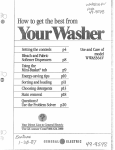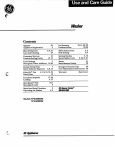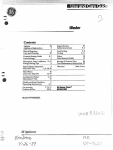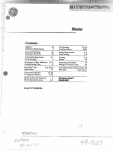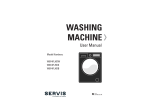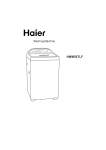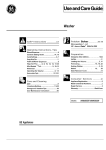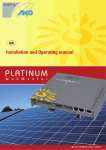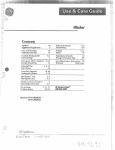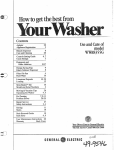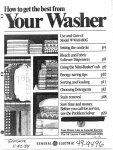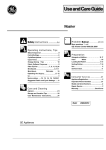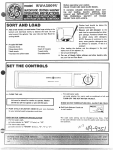Download GE WWA9800M User's Manual
Transcript
washer
contents
Agitator
Appliance Registration
29
2
Pre-Treating
Problem Solver
Bleach Dispenser
Care and Cleaning
6,8, 10
29
SafetyInstructions
Soak Setting
Consumer Services
Controls Setting Guide
31
12, 13
Sorting Clothes
Spotscrubber Cycle
13,14,20,22
23-28
3,4
5,6
4, 14
4, 10,11,21
CycleSettings
5
Detergents, Other Additives 16-20
Stains
Stain RemovalGuide
Energy-SavingTips
Fabric Softener Dispenser
Storage&VacationTips
29
User Maintenance Instructions 29
Filter-Flo@Pan
Hard Water
7
6,8, 10
4,7,8, 10,15,29
19
Limestone Deposits
Loading
17,29
4, 15
Mini-BasketTMTub
Mini-Quick Cycle
8-11
9
Model and Serial Numbers
Operating the Washer
2
4,5
Warranty
21
22
Back Cover
GEAmw@rcenter@
8~a62&2@80
Model WWA9800M
1
t
i “_
--
IfYouNeedSetieeo
—
It is intendedto help you operate
and maintainyour new washer
properly.
Keep it handy for answersto your
questions.
If you don’tunderstand something
or need more help, write (include
yourphone number)
Consumer Affairs
GE Appliances
Appliance Park
Louisville,KY40225
If youreceiveda
dam~ed Wwher. .
●
Immediately contact the dealer
(or builder) that sold you the
washer.
savetime
and money.
Beforeyou request
service. ..
check the Problem Solver on
pages 23-28. It lists causes of minor
operating problems that you can
correct yourself.
writedownthe modei
andserialnumbem.
Toobtaina Spanishlanguage
versionof thisbook, call
GE AnswerCenter”
800.626.2000
consumer informationservice.
Paraobtenerla versi6nen
espafiolde estemanual,
name a
GE AnswerCenter?
serviciode informaci6n
para el consumidor,
te16fono800.626.2000.
FOR YOUR SAFm
If you smell gas:
1. open Windowsa
2* Don’ttouch
electrical switches:
3. Extinguish any
open flame.
4, Immediatelycail
your gas Suppliera
e!ectricswitches
‘Oon’tturn
on oro~ because sp*rks may
ignitethe gas.
1
You’llfincithem on a label on the
lowerleft side near the front.
These nurnbcrsare also on the
Consumer Product Ownership
RegistrationCard that came with
your washer. Before sending in this
card, please write these numbers
flcre:
fvlodel
Number
SerialNumber
To obtain service, see the
Consumer Services page in the
back of this book.
We’reproud of our service and
wantyou to be pleased. If for some
reason you are not happy with the
service you receive, here are three
stepsto followfor further help.
FIRST, contact the people who
serviced your appliance, Explain
why you are not pleased. In most
cases, this will solvethe problem.
NEXT, if you are still not pleased,
write all the details-inc~uding
your phone number—to:
Manager, Consumer Relations
GE Appliances
Appliance Park
Louisville, Kentucky40225
FINALLY, if your problem is still
not resolved, write:
Major Appliance
Consumer Action Panel
20 North Wacker Drive
Chicago, Illinois 60606
—
.-
-.
-
FOR YOUR SAFEW
Do not Stem or use
gasoline Orotller
flammable
vapom
and
liquids
inthevicinity
of~~~i~
Qranyother
a[opliailce.
r)
\
--’3
~.=.,-,,
: ‘-
.
wAmING–To reduce the risk of
~ Closesupervisionis necessary
if this applianceisusedbyornear
pemomwhen Wingyotlrappliance,
followbasic precautions,
including
children.Donotallowchiidren
toplayinside,onorwiththis
applianceoranydiscarded
fire,electric shock, or injuryto
tilefollowillg:
ifi
~~~e this appliance O~IyfOI’
intendedpurposeas describedin
this Use and Care Book.
@Thiswashermustbeproperly
installedandlocatedinaccordance
withtheInstallationInstructions
beforeitis used.If youdid not
receivean InstallationInstructions
sheet with your washer,youcan
obtainone by contactingthe service
locationnearest you.
—Properlygroundtoconform
withallgoverningcodesand
ordi13ances.
Followdetiils in
appiiancee Disposeof discarded
appliances and shippingor
paekingmaterials
properly.
Beforediscardingawasher,or
removingfro~II
service,remove
thewasherlid.
~Keepall laundry aids (SUChas
detergents,bleaches,fabricsotiners,
etc.) out of the reach of children,
preferablyinalockedcabinet.Observe
all warningson containerlabelsto
avoidpersonalinjury.
~Keepthe area around and
underneathyour appliancesfree
fromtheaccumulationofcombustible
materials, such as lint, paper, rags,
chemicals, etc.
~Keepthe floor around your
appliancesclean and dry to reduce
thepossibility of slipping.
@Tominimizethe possibility
of electric shock, unplugthis
appliancefrom the power supply
before attemptingany maintenance
or cleaning (exceptthe removaland
cleaning of the lint filter).
NOTE: Turning the Cycle Selector
knob to an OFF position does NOT
disconnect the appliance from the
power supply.
@~~ ~ot tamper with Controls.
@Do not operate this appliance
if it is damaged, malfunctioning,
partially disassembled, or has
missing or broken parts, including
a damaged cord or plug.
o Never climb on or stand on the
washer top.
:,“
QDo not wash fiberglass articles ill
yo~lrwasher. Skin irritation cot]ld
result from the remaining ~Jarticles
that may be picked ~lpby clothing
duri~lgsllbsequ61?twasl~~rtlse.
i>
\
(contill:~clftz~?.rt
p[!~;e) ~>
––—–7.”’”=’
1,
Impotint
safety
Iwtructiom
(continued)
@Tile laundry process can reduce
the flame reta~dancyof fabrics, To
avoidsuch a result, the garment
mwufacturer’s care instructions
shouldbe followedvery carefilly.
Howtoopemte
SAW TmsE
-:“
msTRucTIoNs
For washer operation
Do not leavewasherlid up
during cycle. This will stop the
water fill, wash and spin action and
preventcompletionof the cycle.
@
your clothes
washer
1
Wm~G—To reducethe riskof fire,electricshock,orinjuryto persons,
readthe WORT~
SA~TY INSTRUCTIONSbeforeoperating this appliance.
WasWSpin Spaods
Variable Water Level
Wash/Rinse Temp.
Spofscrubber
SpotscrubberEightCycle Washer
Sorthg and bading
~ Sort clothes carefilly by fabric
type, weight, color and amount of
soil, according to instructions on
page 14.
~ Remove Filter-F1o@pan and
Mini-BasketT”tub. The underside
of the lid is a good place to put the
pan while loading or unloading
clothes..
~ Load clothes into the wash basket,
beingcarefulnot to overload.Clothes
should be below retaining ring. See
page B for more loadingMormation.
@Position the Filter-Flo pan on the
agitator. Lint will collect in the pan
for easy removal when the wash is
finished,
N~E: Do not use the Filter-Flo
pan as a wash basket. Do not put
any items to be washed in the
Filter-Flo pan.
e See page 6 for information
on how to use Bleach and Fabric
Sokner Dispensers.For information
on bleaches and fabric softeners,
see page 20.
Do not use Mini-Basket tub when
washing regular loads. You’llfind
complete details on how and when to
usc the Mini-Basket tub on pages 8
through 11.
QAdd meastlred amount of
detergent. See pages 16 thro~]gh
19
for information ORdeterge~~tsand
[)fher:idditives.
~~ose the }i~, ~as~er Wil] not fill,
agitate or spin with the lid open.
Q
Use the Controls Setting Guide on
pages 12and 13to help you make
tile i]roper selections.
r
1
~
iPPRESS
Ii
HaavyDUIVExfraLarge Capacity
Regular Cycles
❑
soakc“,{. * o
~
~ Kmls
~
Permanent Press
and Knits Cyc/es
@ Select WaterLevel.
SMALL: Washer is less than 1/3
full of clothes.
~~DILTM: Between 1/3and 1/2
.
LARGE: Between 1/2and 2/3 full.
EXTRA LARGE: Over 2/3 full.
MINI-BASKET: Not used for
regular loads. See pages 8 through
11for instructions.
If you want to increase the wate~
level afier you’vemade a selection,
turn knob to “RESET” and select
new level.
@ Select Wash and Rinse
Temperature. Cold rinse will be
automatically provided with use of
Permanent Press and I<nitsCycles.
(An extended cool-down spray
rinse and cold-water deep rinse are
provided to minimize setting of f+)
wrinldes. )
</”
@ Leave SPOTSCRUBBER
control at Iefi position.
i..=--i>--—
,~
Push Cycle Selector knob in
and turn clockwiset.oyour selected
washsetting.
For most cottons, linens, work and
play clothes with normal soiling.
@ Pull Cycle Selectorknob out to
start the washer. If you wish to
changesetting after washer has
statied, push ‘CycleSelector knob
in to stop the washer and reset to
the newpositioil. Setting can be
changedat any time.
(
Spotscmbber I
seep~es u and H for
controls setihg
Gtide.
Permanentmess and
ah
Use with most soakingaids to
loosen’embedded soils and stains.
cycRes—
For permanent press and knits
loads such as shim, blouses,
dresses and similar wearing
apparel with normal soiling. An
extended cool-down spray rinse is
provided to minimize wrinkling.
Spotscrubber Cycle
M-hat happemineach setting
(approximateminutis)
Permanent Ress
and Knits cycles
Regular cycles
Heavy
I
I
I
5
‘ni&
lsOakcyclel
‘“press
10
5
3%
I
It ‘orma’ I ‘ig’’’soi’
1
19
3%
?
15
I 3% I
1717171
!
3%
I
I
13%13%
4ti
1
4%
,
1
,
i. ~
..
-j
when
washing
regular loam
How toUnsethe
BleachDkpemer
o*
o
How towe the
W’brie softener
Dispemer
I
How tome
the
soak cycle
‘0ak
“’v
p@:4
*
AU1O EITM
RINSE
—
off
Oe
START
Spotscrubber
~ Use this dispenserwith liquid
bleach only.Ifyouprefer to use
powdered bleach,pour it in~othe
washbasket along withyour
detergen{.Do not put powdered
bleach into the bleach dispenser.
~ Measure bleach carefilly. Here
are some recommended amounts:
EXTRA-LARGE WATER
~ Positionthe Fabric Sofiener
Dispenser on the Filter-Flo pan.
~Pour the manufacturer’s
recommended amount of fabric
softenerinto a standard measuring
cup.
@Add enough water to fill the cup
1/2full.
LEVEL:
I%cup (310ml) liquid
~ Pour the diluted softener into the
dispenser.
SMALL WATERLEVEL:
2/3 cup (170ml) liquid
@The fabric sofiener will
automatically be dispensed at the
proper time.
MINI-BASKET TUB:
1/4cup (60ml) liquid
~ Pour measured amount of liquid
bleach directly into the bleach
dispenser.
@Do not overfill or allow the
dispenser to overflow. Avoid
splashing. Undiluted bleach can
cause fabric damage.
~ Do notstopthe washerduring
thefirstspin. This will cause the
dispenser to empty too soon.
= Do not use the FabricSoftener
Dispenser with the soak setting.
@If the rinse dispenser gets
clogged, soak it in a so~utionof
1 cup water and 1cup alcohol.
@“SOAK~CLE” temperature is
controlledby the Rinsetemperature
switch.(Ifa warmsoakis desired, set
theWASH/~QSETEMPEWTURE
switch to “HOT/WARM~’
@If a hot soak is desired, set the
WASH/MNSE TEMPERATURE
switchto “HOT/WARM” and turn
.the Cycle Selector knob to
“NORMAL” in the Regular Cycl
Start the washer. Afier washer fills
and beginsto agitate,push in the
~,
--Cycle Selector kiioband turn to
“SOAK ~CLE~’ Pullout the cycle :..=:~_
“
Selector knob to complete the cycle.
:
@For an extended soakallowthe
washer to fill and agitatefor a few
minutes to dissolvethe soaking
agent. Then push in the Cycle
Selector knob to stopthe washer
(keep lid closed) and allow to soak
for as long as desired. After desired
soak period, pull out the Cycle
Selector knob to complete the cycle.
If your clothesand householditems
don’tlobk clean and fresh afier
washing,you will probablyre-wash
them . ..and that means you’llwaste
energy.Rememberto sort your
clothes carefully,and load them
properly, select correct cycles,use
enough detergentand choosea
watertemperaturewam enoughto
releaseand gel rid ofsoil.
The Filter-Flo pan has two
functions:
@LINT FILTER—Positionthe
Filter-Flo pan on the agitatorafier
~oadingclothes into the washer.
Lint is easily seen and removed
afier the wash is finished.
@Use Hot Wash—upto 150°F.—on
a regularbasis only when washing
heavilysoiled articles-such as
work and play clothes.
@Under normal soii conditions,
wash in water above80”F.(~°C.).
This generally means using the
WarmWashtemperaturesetting
on your washer—temperatures
approximately90° to llO°F.or
hand comfo~ble, If you notice
that soil has accumulatedafier
severalconsecutivewashings,use
Hot Washoccasionally,if safe
for fabrics.
~ Alwaysrinse in Cold Water.The
temperature of the rinse does not
affect cleaning.
@Try to wash less ofien. Save
articles of the same type of fabric
until you have a full load.
@LID FOR THE MINI-BASKET—
After loading clothes in the Miniasket tub, be sure to replace the
1ter-F1opan. The pan serves as a
Iid to keep the clothes in the MiniBasket tub.
N~E: Do not use the Filter-Flo
pan as a wash basket. Do not put
any items to be washed in the
Filter-Flo pan. Do not place
detergent packets in the Filter-Flo
pan.
~ If you must wash smaller loads,
adjust the amount of water. Small
loadsshouldhavelowerwater levels.
@Washin off-peak utility hours.
Yourlocal utility can tell you which
are the off-peak hours.
@Use Normal Spin Speedto remove
more water and help lessen drying
time. The dryer will remove any
writies caused by the Normal Spin.
@Use your Mini-BasketTM
tub for
very small loads. It uses less water
than the small water level in the big
tub on this washer. Youwill also
saveon detergent and energy.
I
,’. -
~
~pical Mini-BasketTM
tub
Wwh loads
@Delieateloadssuchas lingerie,
pantyhose, girdes, blouses,
sweatem9sock, shi*, baby
clothes and other small delicate
hand washables
5. Afier loading clothes in the
Mini-Baskettub, be sure to replace
the Filter-Flo pan. The pan se~ves
as a lid to keep the clothes in the
Mini-Baskettub.
~ Tennisshoes
7. Add fabric softener, if desired
(but not in the Mini-Quick Cycle
described on page 9). Place the
Fabric SofienerDispenser on the
Filter-Flo pan. Pour 1 teaspoon
(5 ml) of concentrated softeneror
1 tablespoon (15ml) of diluted
softenerinto a standard measuring
cup.
Add enough water to fill the cup
1/2full.
Pour the diluted sofiener into the
dispenser.
8. Close lid. Set controls as follow
\
2. PlawMini-Baskettub on agitator.
Pull the agitator toward the front of
the machine for easier installation
and removalof Mini-Basket tub.
3. Pat detergentin the bottom o}”
~heMini-Basket tub before lotiing
cloihgs. Seepage 18.
4. Load clothes in Mini-Basket tub.
See page 14for sorting help.
6. Addbieash, if desired. Measure
carefilly and p-ourrecommended
amount of liquid bleach—1/4cup
(60 ml)–directly into the bleach
dispenser.
—Do not overfill or allow
dispenser t~ overflow. Avoid
splashing. Undiluted bleach can
cause fabric damage.
–Never pour’undiluted Iiquid
bleach directly onto clothes or
into the Min;-Basl~ettub.
—Ifyou prefer to use powdered
bleach, pour it into the MiniBasket tub along with your
detergent. Do not put powdered
bleach into the bleach dispenser.
SpeciaE
imtruatiam for we ofthe Mini-BasIiePtub
oDo not wash clothes in the
regular wash basket when using
the Mini-Basket tub.
~ Shake sand and/or loose dirt
out of clothes before loading;
other~visesome may remain in the
iLlb:Iild011tile Clotilesafter ttle
cycle is Complete{l.
i-..——
~ When washing stockings,
panty hose and other easily
tangled items, alwayshandle
separately. To minimize tangling,
the use of a net laundry bag is
recommended.
.
0
0
EXTRA LARGE
LARGE
MEDIUM
(
S
SMALL e
—SetWater Level to the MINI—
BASKET position.
—Selectdesired Wash/Spin Speed
and Wash/Rinse Temperature.
See page 4.
—Selectdesired cycle—Regular
(Normal), Regular (Light Soil),
Perm Press or Knits. See page 4.
~~=’~~’
=START
&
‘
*-LJ~$
/
g]
‘\
.-
-“ t
b
,-.,
J
i/f “ ‘>
~<%#l
.. ‘“
*
3. Pull Cycle Selector knobto start
washer. Cycle will be completed
automatically.
math~pp~~
du~iw
the
w-Qtickcycle
\
1. Followall the steps given on
page 8 except for cycle selection,
Wash . . . . . . . . . . . . ..3minutes
Spin . . . . . . . . . . . . . ..l% minutes
Rinse . . . . . . . . . . . . ..l% minutes
Spin . . . . . . . . . . . . . ..2% minutes
TotalTime . . . . . . . ...13 minutes
@Totaltime includes pauses
between each phase of the cycle.
-1
Spotscrubber Cycle
~ Totaltime does not include water
fdl times. FiIl times vary depending
on household water pressure.
I
2. Pushthe Cycle SeIector knobin
and turn it clockwise to the MINIQUICK Cycle.
‘1
special imtructiom for we Ofthe Mini-BasketT” tab
Howtowethe Spokcrubber Cycleforremovi%
sPmscRuBBERQck
removesshim and hea~
soilautomatically
The S.~CRUBBER
Cycleuses
a high concentrationof detergent
in about two gallonsof water and
is designed to removestains
automatically.~o rinses remove
the concentrateddetergentsolution.
Stiin RemovalShorkut
HowtoMse the
s~msc~u~~~~
c~~k
~pical SPOTSCRUBBERCycle
Wash had
~ 1 averagesize tablecloth, or
@3 shirts or blouses, or
@1 shirt and 1 pair of slacks, or
@1 fill size bedsheet, or
@3-5 baby garments, or
@5-6 undergarments
1. RemoveFilter-Flo pan.
Many stains that have not set into
the fabric can be automatically
removedin your washer’s
SPOTSCRUBBER’
cyc~e.
Step 1. Launderanystainedwashable
fabric with the SP~SCRUBBER
Cycle, using the hottest water the
fabric can stand and the
recommended amount of detergent.
Step 2. If the stain remains—and
if the stained article is white or
bleachable—washit again with the
SPWSCRUBBER Cycle, using
warm water and bleach (seepage
13)plus the recommended amount
of detergent.
Chances are Step 1 wili remove
the following stiins:
@Fresh Blood
~ Perspiration
@Cosmetics, Grease, Oil
~ Chocolate, Cream, Ice Cream,
Milk
@Most Common Food Stains
odds are good that step 2 will
remove these shills:
o Grass, Foliage, Flowers
o Aged Blood
@Anti~Ocrspirants,~eOC]OrantS
Gcoffee and Tea
@Fresh Fruit. Fruit Juices, Wine,
Food Coloringj VegeQbles
stiim
-
Wu \
2. Place Mini-Baskettub on
agitator. Pull the agitatortoward
the front of the machine for easier
installation and removalof MiniBasket tub.
3. Put detergent in the bottom of the
Mini-Basket tub before loading the
clothes (about the same amount
you would use for a small load in
the regular wash basket. See page
18.)Do not use detergents with a
built-in fabric softener. If you do,
some soil may be redeposited on
the wash load.
4. Load clothes in Mini-Basket
tub. See page 14for sorting help.
~.Add fabric softener9if desired
@utnot in the Mini-Quick Cycle
described on page 9). Place the
Fabric Softener Dispenser on the
Filter-Flo pan. Pour 1 teaspoon
(5 ml) of concentrated softeneror
1 tablespoon (15ml) of diluted
sofiener into a standard measuring
cup.
Add enough water to fill the cup
1/2fill.
Pour the diluted softener into the
dispenser.
7. Add Bleach, if desired.
Measure carefully and pour
recommended amount of liquid
bleach–1/4 cup (60 ml) directly
into the bleach dispenser.
—Be sure to add bleach before
starting the washer.
—Do not overfill or al~ow
tiS~e~Ser to overflow. Avoid
splashing. Undiluted bleach can
cause fabric damage.
–Never pour Undilwted liquid
bleach directly onto clotRlesor
intotheMimi”Basl$et
tub.
-.-... -”-.
j
,
I
I
I
I
t
RegularCycles
Baskettub along with your
detergent.Do not put powdered
bleach into the bleach dispenser.
Soak
Cr./o
* o
NonM&l
8. C1osethe washer lid and set
the controlsas follows:
–Select desired Wash/SpinSpeed.
—Selectdesired Wash/Rinse
Temperatures.Pi-operwash water
Temperatureis important. Referto
the Controls SettingGuide, page 12
and StainRemovalGuide, page22.
I
~
~
‘
nfAw
Orr>
AUTO
irliA
p~
--Q;
L!G}I1 SOIL
RIM%
o
OF,
-~a START
~~ Min!-iluick Cfcle
(
**
e
Oa
I
off
START
Spofscrubber Cycle
I
—Push Cycle Selector knob in and
turn it to STARTsetting in the
SPOTSCRUBBER cyCle.
*
START
EXTRA LARGE
LARGE
MEDIUM
I
(
~
—Pull Cycle Selector knob to start
washer.
\
SMALL
-G
‘act WaterLevel control to MINIZ.4SKET position.
-
ON
L
I
*~tink you need more water when
adding a large item such as a
tablecloth? Waitabout a minute
afier agitation begins, then check.
Toadd water, stop washer, reset
SPOTSCRUBBER control to ON
and restart washer. Leave Water
Level control at MINI-BMKET.
Forbest resul~s,don? overloadthe
Mini-Basket tub. It k better to do
two loads so laund[y can move
freely in the wate~
I
I
When agitationbegins, the
SPOTSCRUBBERcontrol moves
counterclockwisefor about half a
minute. A sharp distinctivesound
will be heard soon after agitation
begins. This is the sound of the
water recirculation systemcutting
off to keep the concentrated\
detergent solution in the MiniBasket tub. When agitation stops,
the SPOTSCRUBBERcontrol
moves the remaining distance to the
left and rinsing begins.
Cycle sequence:
Wash . . . . . . . . . . . . . ..l5minutes
Spin .oo . . . . . . ..o. ..3% minutes
Rinse . . . . . . . . . . . . . . ..3n~inutes
Spin . . . . . . . . . . . . . . . ..3minutes
2nd Rinse . . . . . . . . . . ..3minutes
Spin . . . . . . . . . . . . . . . ..7minutes
TotalTime* . . . . . ...43 YZminutes
*Includespausesbetweeneachphaseof
thecycle.Doesnotincludewaterfilltimes
whichvarydependingonhouseholdwater
pressure,
–Set SPOTSCRUBBERcontrol to
ON position, This fills the MiniB:~skcttub half full of water which
is rlormalYK
specialilwtruetiom foruse Ofthe Mini-BaslketTM
tub
~ Do not wash clothes in the
regu~arwash basket when using
the Mini-Basket tub.
<1Younlust usc the Mini-Basket tllb
with the SPOTSCRUBBER~J~C[C.
Q Shake s:3ndal]d/or Joose dirt
out of clo[hes before loa(iing;
otherwise some may remain in
the tub and on the clothes afier
the cycle is completed,
o When washing stocltings,panty
hose and other easily tangled,
items, alwayshandle separately.
TOmil)irnize tangling, the use Ofa
net laundry bag is recomme~lded.
wash water
Temp.
wash/spin UseColdRinse
had
speed
cyclesetting
to SaveEnergy
Cottons
andLinens
White/Colorfast
Bright/Non-colorfast
Normal/Norma Hotor Warm*
Norrnal/Norrna Warmor Cold
WorkClothes
Heavysoil
Normal/Norma Hot
RegularCycles
RegularCycles
~ormalor LightSoilS.-:::
Vorrnalor LightSoilS=””
RegularCycles
VormalSoilSetting
Spotscrubber Cycle**
Averagesoil
Normal/Norma Hotor Warm
PermanentPress,TreatedCottons,
BlendswithCottons
Heavyor oilysoil
Normal/Gentle
Hot
RegularCycles
~ormalSetting
PermanentPressandKnitsCycles P.PressSetting
Spotscrubber Cycl@*
Averageor lightsoil
Synthetics-Polyester,Nylon,
AcrylicKnitsandWovenFabrics
Sturdy
Delicates
Silks,Wools;BlendsofSilk
andWool
~ Down-filledgarments,if machinewashing
isrecommended
BabyClothes—Sturdy,
suchasDiapers,
Nightgowns,Shirts,Pads,Sheew,
ReceivingBlankets,Coverails
BabyClothes—Delicate
Blankets-Wool,Part-Wool
Blankets-Synthetic,Electric,Cotton
Normal/Gentle
Warm
PermanentPressandKnitsCycles 1?PressSetting
Normal/Gentle
Gentle/Gentle
Warm
Warm
PermanentPressandKnitsCycles P.PressSetting
PermanentPressandKnitsCycles 1?PressSetting
Gentle/Gentle
Warm
PermanentPressandKnitsCycles Setat Knits
Gentle/Gentle
Warm
PermanentPressandKnitsCycles Setat Knits
Gentle/Gentle
Warm
PermanentPressandKnitsCycles E?PressSetting
I
I
Normal/Normal Hot
I
Gentle/Gentle
RegularCycles
—
Normalor LightSoilS<::!
dependingon amountofs!
Spotscrubber Cycl@*
Warm
PermanentPressandKnitsCycles P.PressSetting
Spotscrubber Cycl@*
5 min. soakthen Warm
I Gentle/Normal
5 min. soakthen Warm
Normal/Normal
RegularCycles
LightSoilSetting
RegularCycles
LightSoilSetting
WASH
Curtains–DON~ MACHINE
FIBERGLASS
Gentle/Gentle
Hotor Warm
PermanentPressand KnitsCycles P.PressSetting
ChenilleBedspreads,RobesT
Gentle/Gentle
Hotor Warm
PermanentPressand KnitsCycles P.PressSetting
Slip-covers,
Draperies,BathmatsandRugst
Normal/Normal Hotor Warm
RegularCycles
NormalSetting
Denims(especiallyIndigoBlueJeans)and
{}therfabricsthatbleed
Normal/Normal Coldor Warm
RegularCycles
NormalSetting
1
W3rm
PermanentPressand KnitsCycles Setat I{nits
;“--L\
Warm
......-.—-—.—,—,
,— .....—
>.2
PermanentPressand KnitsCycles
Liquidchlorinetype.
Onlynon-chlorinebleachwhenneeded.
If colorfastitemsareunusuallysoiled,usehotwater.Usedetergentrecommended
inguide
I onpage18.
Usedetergentrecommended
inguideonpage18.
Forheavilysoiledloads,useextradetergentandlongerwashtime.
Whiteor colorfast,liquidchlorinetype.
Non-colorfast,onlynon-chlorinebleach
whenneeded.
Whiteor colorfast,liquidchlorinetype.
Non-colorfast,onlynon-chlorinebleach
whenneeded.
Usedetergentrecommended
inguideonpage18,
Forheavilysoiledloads,useextradetergentandlongerwashtime,
Whiteor colorfast,liquidchlorinetype.
Non-colorfast,onlynon-chlorinebleach
whenneeded.
If unusuallysoiled,usehotwater.Usedetergentrecommendedinguideonpage18,
Forheavyor oilysoil,useSpotscrubber Cycle. Seepage 10.
Syntheticsandblendsusuallyrequireslightlymoredetergentthancottonsforcleaning
andtohelppreventloosenedsoilfromcollectingonthefabric.
Nobleach
I
Washonlyif recommendedbythegarmentmanufacturer.Followinstructionscarefilly.
B
Seldomneeded.If needed,useonly
non-chlorinebleach.
Washinyourwasheronlyif recommendedbythegarmentmanufacturer.
Nobleach
Washfrequentlyto fluffupthedownandretainthegarment’swarmth.Washseparately.Wet
downgivesoffanodorwhichmaybeabsorbedbyothergarments,Odordisappearswhen
garmentisdry.Treatheavilysoiledareaswithliquiddetergentor pastemadeofwaterand
granulardetergent.Closezippers.Wash2 or 3 at a timeor addtowelsto balance.
GARMENTMUSTBETUMBLEDRIED.
Vhiteor colorfast,liquidchlorinetype.
Youmayprefertousea mild-typedetergent.Dobabyclothesseparately.Pretreatspots.
Rinsediapers,nightgowns,
padsandsheetsafteruse.Keepdiapersina coveredpailofcold
waterandconditioningagentlike,Borateembrand.
)nlynon-chlorinebleachwhenneeded.
Youmayprefertousea mild-typedetergent.Dohand-knitgarmentsbyhandor in MiniBasket’’”
tub-see page8.
0 bleach
Fill washer,adddetergent,allowdetergentto dissolvebeforeaddingblanket.Doone
blanketat a time, Pretreatheavilysoiledspotswithliquiddetergent.
o bleach
On electricblanket,sewa strongpieceofclothoverplugto protectblanketandwasherfrom
damage.Dooneblanketat a time.Pretreatheavilysoiledspotswithliquiddetergent.
‘hitcor colorfast,liquidchlorinetype.
1
Vacuumoutloosedirtbeforewashing.
hitcor colorf~st,liquidchlorinetype.
[ If unusuallysoiled,use Normal/GentleWash/SpinSpeed.
hitcor colorf:~st,iiqui(ichlorinetype,
~ Washonly2 or 3 mgsormatsatonetirne. Shakebeforewashingtoremoveexcessdirt.
1
For new “indigoblue”jeans, washat least3 timesin verysmallloadswithfullwaterfiil.
~ Nobleach
~
Jeansneedampleroomto moveto avoidwhitelinesat creases.Maydiscolorplasticwasher
I
parts.Subsequentwsshingswill reducediscolorations,but willprobablynevereliminateit.
i
The stainedpartswillnotdiscolorsubsequentwashingloads.
#
.—- 8
Ttlmbleon FLUFF(NoHeat),
~ N()bleach
ii-~.
---%
I
_—--l
..i-:
x- --z.;,_-_.==___
-~
I Pillowsarc intideofdifferentmaterials—dacron,fiber,foam,polyester,natt~ralfeathersand
,, Nobleach
~ down,Manypillowscanbc machinewashed,but r)m)zufacture)x’care labels tnmt befollowed
/-,.,‘----g
1,g
! cLIrej~//y.If washingis recommended,checkpillowsfor weakseamsor l~olesand mendto
:~
.,j
-,. . ;
[ preventescapeof fc:~rhrrs
or filling,Fillwasher,adddetergentandagitateforseveralminutes
,i
detergent.Addtwopi}lows
at a timeto baianceload,usinge;{tr~largewaterlevel.
~
tcl <fiss(]lvc
.—
—!l—
.-i
—..”
—.—,-..—,—
-.
i~]f(lrii]iitit~r~
on (:i~r(~ labcli[l:. s~’nt!
ii~r“}!rhat’sNcv:Pibotit “QPiF.E LABELS:’
! ~’;~ll{~m
}. .Ir :;;;Ic b:< !hc Superin[endcfit
ofD{>t:unlcn[s.
,( :... .<3(3Vt:i’IlnlCilt
..
Priililll:y
Offic)c,
1’\T:2Slliii~{i<J[l, lj.C. 20<-[)2.
iq
.
God sortingmeambetterwashing
Separate
It pays toCheekand prepare
clothes forWashing.
~epa
@Empty pockets,bmsh out cuffs,
zip zippers, snap snaps, hooks
and buttons.
from
from
Check all items for areas of heavy
soil or stain.
1
LINT PRODUCERS— Such aS
te~ towelingand chenille—give
up lint.
from
w
LINT COLLE~RS—
such as
man-made fibers and napped
fabrics like velveteenand corduroy
—attractlint. These must be
washed separately.
For more informationon lint
control?see page 23.
Soti by fabtic
separate
@Removestains. Use the
SpotscrubberCyclethat’sdesigned
to removestainsand stubborn soil
automatically(see page 10),and
refer to the StainRemovalchart on
page 22 when you elect to pre-treat
and scrub stainsby hand.
Turn Poly Knits inside-outto
minimize fabric surface damage.
Soaking Boosensdeep soils and
shins.
A thorough soakingwith detergent
or special soaking agent is another
way to removeheavy soils,
embedded dirt and even some
stains.
I
Separate
from
soaking can be either a completely
separate washing step or a preliminary step to a complete wash cycle.
For detailed information on how
to soak in your washer, see page 6.
from
from
from
from
~ Do any necessary mending—rips$
hems, tears.
e Pre-treat heavy soil by rubbing in
a small amount of liquid detergent
or a paste made of water and
powdered detergent or soap. For
best results, wait % hour before
washing. Or wash small, extremely
soiled loads in the Mini-BasketTM
tub using th~ Spotscrltbber Cycle.
See page 10.
-_
‘ti
special
reeommentitiom
forWmting permanent
press
if you do nothave a dryer.
If you are machine-washing
Permanent Press clothesthat you
plan to hang or drip-dry,use extra
care to minimizewrinklingin
the wash process:
@Be careful not to overload
washer. Permanent Press clothes
must haveample room to move
freely. A Medium size Permanent
Press load is the largestthat should
be washed.
@Use more water than you would
for a regular load. Use a Medium
Water Level for a Small Load; an
Extra Large Water Level for a
Medium Load.
~ Removeclothesas soon as washer
stops and hang immediately.
~ To minimizewrinkling,use
Normal/Gentleor Gende/Gentle
Wash/SpinSpeed, dependingon
fabric or amount of soil.
@Load clothes dry.
~ T&e a properly sorted group of
clothes and drop them loosely in
the wash basket in this order:
Large Items—like sheets. Do not
wrap around the agitator.
..;-, -.:=
..:
.-.
.-~a.z:
@
~Inall
Items—1ikewashcloths,
This illustration, with clothesjust
reaching the Clo[hes Retaining
Ring, shows a proper load. Clothes
have ample room to move because
they are not packed down, nor
wrapped around the agitator.
Clothes are loaded dry since wet
items are apt to pack down which
encourages overloading. This size
load requires a full water fill.
what is the best size load of
clothes—large9 medium9 or
small? savetin2e3
energy
and
by avoidingextra use of
detergent
the washer. Try to wash a fill load
of clothes. If you can it is better to
save clothes unti! yoLlhave a fu~]
load. If yoL]must wash smaller
loads, save water, energy and
detergent by adj~sting the water
level for t,hesize of the load. See
page ~i.
To add itemsafter the washer bm
satiede
= Turnoff the washer.
@Carefully removethe Filter-Flo
pan.
@Add any additiond articles by
submergingnext to tie agitator.
~ Replace the Filter-Flo pan and
restart the washer.
N~E: Do not use the Filter-Flo
pan as a wash basket. Do not put
any items to be washed in.the ‘FilterFlo pan. Do not place detergent
packets in tie Filter-Flo pan.
N~E: When washing stockings,
panty hose md other easily &ngled
items, alwayshandle separately. To
mititize tangling, the use of a net
lau~]drybag is recommended.
1
1
i
k
.’
Factorstoeomider inse~ecting
dete=enti and soap
Mmtigw
Perform well in hard or softwater
Are not availablein someareas.
Washall types of fabricswell.
Can be used in hot, warm, or
coldwater.
Perform satisfactorilyin soft
or moderatelyhard water.
Generally do not clean well in
hard wa$er.
In someareasonlynon-phosphate
productsare available.
Maybe difficdt to dissolve,
especiallyin coldwater.
Shouldmt be usedin coldwater.
Thosecontainingsodium
carbonateas an ingredientmay
causeharmti limestonedeposifi
on clothesand washerwhen
combinedwithhard water.
(Seepage 17.)
Petiorm well in sofi water.
Offer better performance in
hard water than powdered
non-phosphatetypes.
May not perform as wellas
powderedphosphate products
when dilutedin wash water.
Cleans synthetics and fabric
blends well.
Are excellent as concentrates
for removing spots.
Completely dissolve even in
cold water.
Help make clothes fluffy and soft.
Reduce static electricity.
Perform well in sofi water.
Generally do not clean well.
Loosened soil is likely to be
redeposited on clothes.
Generally do not clean well in
medi~~m-hardor hard water.
May combine with water
Ilardness minerals to form
sticky soap curd.
——
J.6
..-,
.,.—%
:
~
~neradk of
d
conthlued
z.=y==~
..- .+, ~
.
Is your water hard? If it is, and if
you use a carbonate type nonphosphatedetergent,-~ouwill most
probablynotice limestone*
depositson your clothes and
Efiwk
on
clothes
Althoughlimestone build-up
occurs more rapidly on cotton, it
will eventuallyaffect various
fabricsin the followingways:
* Gives a stiff, harsh, rough feel to
fabricssuch as toweling,
~ Causes colors to fade and
becomedull and dingy.
~ Causes graying of fabrics.
~ Leaves a white, powdery residue
on dark-colored items.
~ Causes spot-fadingof bright
colors as a result of direct contact
with detergent.
educes wrintie-resistance of
~rmanent-pressfabrics.
_.— ~ Destroyseffectivenessof flameretardant finishes on cottons such
as children’ssleepwear.
@Increases fabric wear because of
the scrubbing action between
limestonedeposits on the fabrics
during washer agitation.
Eflmti on Wwher
= Unsightly build-up on all washer
surfaces exposed to the wash
solution,
QMat-like crusty formations
caused by lint adhering to the
s[icky 1imestone deposits.
@Increased service calls because
c}flimestone deposits in the pump,
recirculation water hoses, filters
and other washer parts.
~~Reduced usefu~life of washer.
.>.
--.,,
...~.
{-‘.-=1
..--.,=:>J
—-J
we ofmbnak
dekwen@
washer surfaces. The hardnessof
Yourwater and yourwashing
~requencywill determineh;w
rapidly the limestonewill build up.
If your water is VERYHARD
(11or more grains)and if you wash
iust a few loads a week, you may
;ee limestonebuild-upsin just a
fewmonths.
Rwomended methom@
bdd-u~
~ Increase use of bleaches, presoaks, packagedwater conditioners, prewash soil and shin
removersto help in removing
stubborn soils and stains.
~ Use greater care in sorting loads.
Washvery dirty loads separately
and increase detergentto help keep
dirt from redepositingon less
soiled items. Washdelicate items
separately to preventdamage from
heavy sturdy clothes.
@Wash smaller loads to increase
cleaning action of washer.
@Use fabric softener to counteract
stiffness or harshness in clothes.
reduceb=tine
o Use a powderedphosphate
detergentor a liquid detergentif
these are availablein your area.
@Install a home water sofiener.
This will significantlyreduce
limestonebuild-up.
~ Use a packaged non precipitating
water softener, such as Calgon
brand with phosphate.
pmctiea
Wd
Wmx
ma. delay Mabne
-we
h Cloth&
The followingrecommendations
will temporarily delay the effects
of limestone on your clothes.
These are generally good washing
practices and will give better soil
removalwhether or not you have
hard water or use carbonate
detergent.
~ Use hotter wash water, for
example up to 1500for cottons.
This also improves oily-soil
removal.
~ If you wash in cooler water to
save energy, use more detergent to
promote better washing. Also be
sure to use bleach on bleachable
fabrics. Use hot water whenever
possible.
@Add detergent and allow washer
to fill and agitate for three or four
minutes to dissolve detergent
before adding clothes.
@Increase amount of detergent,
See chart on page 18for recommended detergent amounts in
relation to water hardness.
‘ [ !h4ES~ONE—technically called CAI.CIUIMCARBONATE—is caused bythe
‘- ‘-’-=3i~’.~i;iionof the calci(~min the hard v{ater w~ifhthe sodium carbonate in the detergent.
How h ptiiwy
F@re
Clothw
Once clothes havedeveloped
deposits, they may be partially
restored by soting in a solution
of two cups of vinegar in one gallon
of hot tap-water for 15minutes.
USE A PLASTIC CONTAINER.
Then wash clothes in the washer
using detergent.
@Do not use vinegar soak
solution in washer. The acidic
action of the vinegar may
damage the porcelain.
@Vinegar soak solution may
reduce the wrinUe-resistance of
permanent-press fabrics.
@Vinegar soak may damage the
dyes in some fabrics.
I
Howmuchdete=entshouldyouuse?
The use of a sufficientamount
of detergentis one of the most
importantthingsyou can do to
make sure your wash comesout
clean.
bomt
aeco-
q-
If the recommendedamount of
detergentproducestoo many suds,
switchto a low sudsingdetergent
brand, and followinstructionson
package.
To use granularor powdered
detergent inregular wash loads:
For best results, add detergentto
the wash basketbeforeloading
clothes. If you load your clothes
first, add detergentnext to the
agitator.
If your detergentdoesn’tdissolve
well, pre-dissolvethe detergentin
hot water then pour directly into
the wash basket.
md@s
b:
1. Waterhardness
2. Amount of soil
3, Size of load
4. Type of detergent
5. Washtemperature
To use granular or powdered
detergentinthe Mfii-Basket tub,
usemomdete~ent M
put detergentin the bottom of MiniBasket tub beforeloadingclothes.
youhave.,.
1. Hard water
2. Large loads
30Greasy or oily soils
4. Lower wash temperature
5. Low phosphatedetergent.
To use liquid detergent in regular
clothes basket or Mini-Baskettub,
followpackagedirections.
Using too little detergentis
a common cause of laundry
problems. Alwaysmeasure
detergent in a standard
measuring cup,
—
W’ater
tivel Setting
RegularWashB=ket
Water
Hardness
HighSudsiIlg
Powder~pe
VERY
HARD
10-20Gr,
HARD
4-10Gr.
;:;:
LowSudsing
Concentrated
l>owder~pe
0-10
Grains
LIQUID
0-10
Grains
1. Use recommended amount of
detergent for your load and water
hardness as shown in chart.
MiniBasket~b
Hand
SpotScrubber
Washables
Extra
Large
Large
Medium
Small
2 cups
1%cups
1%cups
1Mcups
+5cup
1%cups
1%cups
1k cups
1%cups
%cup
%cup
%cup
1cup
1cup
%cup
‘hcup
%CUP
1/2
cup
1cup
%cup
‘hcup
‘/2
‘Acup
‘/2
cup
cup
FoLmw PACKAGEDIRSHIONS
2. For other detergent types—low
and normal suds, powders, liquids,
non-phosphate powders—follow
recommendations on package.
3. For hard water treatment, see.
page 19.
have
it?
4-.
Beforeyou can decide what to do
~-~‘ about hard water, you need to know
if you have it and, if so, how hard
.
it is.
@Ii’ you live in a municipal area,
contact your water company.
@If you live in a rural area, or in
some suburban areas, contactyour
county agent.
The answer will be “you have ‘so
many grains’ per gallon” and
means this:
Oto 3 grains per gallon—SOFT
4 to 10grains—HARD
11to 19grains–VERY HARD
20 grains
and over_
EXTREMELY HARD
Add
If your water is SOFT, youhave
no problem. Youcan use soap or
detergentas youprefer and forget
all abouthard water.If youhave
HARD water-less than 10grains—
and you use phosphatedetergent,
you also haveno problem.
But, if you havemore than 10
grains, you will need to softenyour
water with either. . .
1. An installedwater softenerin
your home, or
2. The use of a packagedwater
sofiener.
Forinformationon water
softeners, see guide below.
tlfi much Ivakr Whner dth a M
water
level
Grainsof
hardness
Whenusing
\vithdetergent
Whenusing
}vithsoap
o–lo
10–u
o
‘Acup
(60ml)
*hcup
(160ml)
1/3 cup
(80ml)
15-20
‘/2 cup
(120ml)
%cup
(180ml)
20–25
25–30
2Acup
(160ml)
1cup
(240ml)
1cup
(240ml)
1%cups
(360ml)
over30
1cupplus1tablespoonforevery5 grainsabove
30(240mlplus 15mlforeachextra5 grains)
1%cupsplus1tablespoonforevery5 grainsabove
30(300mlplus 15mlforeachextra5 grains)
I
I
I
I
1)
other
laundry produc@—
special Instructions
BLEACH
ChlorineLiquid
suchas Cloroxbrand
UseyourBleachDispenseraccordingto instructionsonpage6.
1)Donotpourundilutedliquidchlorinebleachdirectly
intowasheror ondryclothes,
2) Someoftoday’swashablefabricsshouldnotbechlorine
bleachedsuchas: 1~ %cottonflame-retirdantchildren’s
sleepwear,silk,wool,mohair,spandex,leather,or non-fast
colors.Dilutebleachbeforeusingonanyfabric.
3) Checkmanufacturer’s
hangtagsforspecialinstructions,
OxygenPowdered
suchas Clorox2
brand
FOI1OW
packagedirections.
Putbleachintowasherwithdetergent.
1)Maybeusedonallkindsof fabrics,
2) Is mosteffectiveinhotwater.
FABRICSOFTENERS
Rinseadditivesuch
as Downybrand
UseyourFabricSofienerDispenser
accordingtoinstructionsonpage6,
1)Helpsmakeclothesfluffyandsoft.
2) Reducesstaticelectricity.
3) Usecarefilly.Toomuchmaycausestainingonsome
clothes,
WashAdditivesuch
as RainBarrelbrand
FollowPackagedirections.
Addduringw2shcycle.
Usecarefully.Toomuchmaycausestainingonsome
clothes.
SANITIZER
ChlorineBleach,
suchas Cloroxbrand
Useincaseofinfectionand
contagiousdisease.
SeeunderBleachabove.
Guardsagainstinfectionbykillingmostbacteria
andviruses.
WATERSOFTENER
Non-Precipitating
suchas Calgonbrand
Followpackagedirections.
Addat startofwashcycle.
Suspendshardnessmineralsin solution,keeping
waterclear.
Precipitatingsuchas
Boraxbrand
Followpackagedirections,
Usewithdetergentor soapin
washcycle.
Combineswithwaterhardnessmineralsto form
precipitatewhichgivescloudyor milkyappearance
towater.
SOAKAGENT
Suchas Bizbrand
Followpackagedirections.
PRE-TREATING
STAINANDSPOT
REMOVERS
such as
Spray‘n“Wash
tindK2Rbrands
Followpackagedirections.Treat
~nlyheavilysoiledareas.Check
yarmcnt’shangtagforinstructions.
>
CAUTION:Washercontrolpanelsandfinishesmaybe
damagedbysomelaundrypre-treatmentsoilandstain
r’emover
productsif suchproductsare sprayedonor have
directcontactwiththewrisher.Applythesepre-treatment
productsawayfromwasher.The fabricmaythenbe washed
normally.Damagetoyourwashercausedbypre-treatment
productsis notcoveredbyyourwarranty.
TINTSANDDYES
Powderedsuchas
RitandTintexbrands
~ollawpackagedirections.
NOTE:Tintedgarmentsmaynotbe
:olor-fast.Washseparately.
Cleanwashertoavoiddiscolorationofnextload.Go
throughcompletecycle(5-rein,wash)usinghot water,
1Acup (120ml)detergent,1cup (240ml)bleach.Wipe
exteriorparts.Caution:Tintingmaydiscolorplasticin
washer.Subsequentwashingswill reducediscolorationbut
maynevereliminateit.
1
-:r\
,.!, g“j
shin RemovalHint—
iManystains that havenot set into
the fabric can be automatically
removedin your washer’s
SPOTSCRUBBER
cycle.
(Seepage 1O.)
Gettingstains out of items that are
too big to be laundered in the MiniBaskettub is more difficult. The
StainRemovalGuide on the next
page suggestswaysof treating
stainsby hand.
Whetheryou usetheSP~CRU..B~
Cycleshortcut or apply stain
removalproducts by hand:
@Try to remove stainsas soon as
possible. The fresher the stain, the
easier it is to remove.
~ Beforeattempting to remove
any stain, check the care label
instructions that came with the
arment.
= Some detergents are more
effectivein removing certain stains
than others. If the stain remains
after you have tried the
SPOTSCRUBBERstain removal
shortcut, try another brand.
-.
If you elect to apply shin
removal produe~
by hand:
~ Find the fabric and the finish in
the guide on the next page, and use
only recommended methods.
@Test stain relmovalproduct on a
hidden inside seam or on a sample
~)fthe material.
Q~oij~w stain remova] with a
thorough rinsing.
~ Washwith recommended amount
~lfsoap or detergent.
.-
%..l
‘ --
‘\
f
,1
.. .
.,
. . . ..
using ch~orineBleachfor
White and Bleaehabje Fabrics.
Mix 1/4cup (60ml) chlorine bleach
with one gallon (3.8liter) ofcool
water—approximately80°F (~°C)—
in a sink or pan. Soakstainedarea
for 5 minutesand launder in washer.
The case Of the
“Invisible” shin
Food or cooking oils on your
syntheticgarments may cause stains
which are virtually invisibieand
which you may not notice as you
put your clothes into the washer.
If these stains are not completely
removed in the wash, the oily spots
may pick up dirt from the wash
water. Then they will become very
visible and you may think they were
caused by the wash cycle itself.
once these spo@bwome visible,
how can you remove them?
e Wash spotted fabrics in the
Mini-Basket tub using the
SP~CRUBBER Cycle and hottest
water the fabric can stand.
~ Another way to remove these
spots is to rub them in undiluted
liquid detergent and let stand 30
minutes, then re-wash using hottest
water the fabric can stand.
How can you prevent these
“After-You-Wash”S@inS?
~ Increase the amount of detergent
normally used.
a Increase water temperature where
fabric will permit.
@Wash synthetic garments more
often.
Launderwiththe SP~CRUBBER Cycle, usingthe hottest waterthe fabric can stand and
the recommendedamount of detergent.
1fthe stain remains—andif the stained article is white or bleachable–wash it again with the
SP~CRUBBER
Cycle, using warm water and bleach(seepage13)plustherecommended
amountofdetergent.
If thestiinedarticleis whiteor bleachable,usewarmwaterandchlorinebleach
(seepage13)plustherecommendedamountofdetergent.Forotherwashable
fabrics,usean oxygenbleach.
Stih that needpretreatment
Wtite and Blwchable Fabrics
“—
Washwithhotwaterand 1/2cupofcitricor oxalicacid~;or apply
commercialrustremover**usingmanufacturer’s
directions,
rinseandlaunder.
Sameas whiteandbleachablefabrics.
Adhesives
(chewirag
gum,
etc.)
Rubwithiceor immersein verycoldwater.Usedulltoolto
carefillyscrapeoffas muchadhesiveor gumaspossible.Sponge
witha safedry cleaningfluid,*thenlaunder,
Sameas whiteandbleachablefabrics.
Inlt,Ballpoint
Freshstains:Placestainfacedownon an absorbenttoweland
spongewithdry cleaningfluid? or usespraycleaner.Apply
undilutedliquiddetergent.Oldstains;bleachper StainRemoval
Hintonpage21.
Sameas whiteandbleachablefabrics
exceptlaunderusingoxygenbleach.
Softenwithoil, lardor petroleumjelly,thenspongewith
turpentineor bananaoil. Launderin warmwater,
Sameas whiteandbleachablefabrics.
Treatstainwithcommercialspotremoversuchas texizeK2r@
brand,followingmanufacturer’sdirections.Repeatif necessary.
Launderanddry.
Sameas whiteandbleachablefabrics.
T9Y
‘*Caution:BecausecIcaningfluidstendto betoxic,be sureYouare in a well-ventilatedroomwhenusin~them. No cleaningfluidshouldbe used
unlessuser is f~rniliarwi~~theIirnitatioilsandrequiredcaitions (usuallyprintedon label),Useextre~e cautionwithflammablecompounds.
~+Do notmixchIorincbleachwithai~~snonia
or acidssuchas vinegaranti/orrus~remover.Mixingcanproducea toxicgaswhichmaycausedeath. ---“1
(: )
[Jndc:rnocircumstancesshouldfabricscontainingflammablematerials(waxes,cleaningfluids,etc.)be washedin washer.
.--’
~{jxzlicacidis toxic.T~kecarenotto ingestit accidentally.
(<--”\
[i..._ ,..’J
.-.a
~
Questiom?
i PROBLEM
ON cLmHEs
POSSIBLE CAUSE ND
WMED’
@Incorrect sortingof clothes. Separate lint-producers(such as kr~
towelsand chenille)from lint-receivers(such as man-made
fabrics, velveteen,corduroy).
@Washingtoo long, especiallyfor smaller loads. For nomal soil,
wash one minuteper pound of dry clothes.
@Use of non-phosphatedetergentswhich combine with hardness
minerals to Form-aprecipita~ewhich can be mistaken for lint. Use
a phosphateor liquid detergent; use warmer wash water or soften
water with an instilled mechanical softener or a packaged water
softener.
Powderyresidue from granular detergent may appear to be lint.
Predissolve granular detergent in hot water before adding to
washer; make sure detergentis completely dissolvedbefore
adding clothes; switchto liquid or cold water detergent or use
warmer wash water, See page 18.
Overloadingwill cause abrasion which creates excessivelint.
Washfewer items with correct water level.
Too much bleach. Use correct amount of bleach according to
packagedirections.
Not enough detergentto hold lint in suspension during wash cycle.
Increase amount of detergent. Seepage 18.
Incorrect use of fabric softener. If used in wash cycle, softeners
may react with detergentto create a white deposit. Use softeners
in rinse cycle only unless package specifies adding to wash cycle.
Use Fabric Softener Dispenser. See page 6.
JPillingusually on polyester-cotton blends is caused by normal
1wear and may look like lint. ~ming
clothes inside-out may ~el~.
$titic electricity caused by overdrying will cause attraction. Use
~abricsoftener in rinse cycle.
GREASY OR OILY
~’-f’’~~~
~~
LAUNDERED
GARIVENTS
___
These are sometimes called “Invisible Stains” because you may not
notice them before washing clothes. However, if ofiy soils are not
completely removed in wash cycle, the oily spo@may pickup diti
from the wash water. The spots will then be very visible. They are
not caused by the washer. VJashsynthetic garments as soon as
possible after wearing. Use more detergent than normal md hottest
water fabric can s~nd. If spots appear, rub in undiluted liquid
detergent, let stand 30 minutes and rewash.using hottest water fabric
can stm~d.Or launder with S’o~scrubber C}~cle—seepage 10.
PossmLE
CAUSE m ~Em~y
PROBLEM
GRAYED
cLmHEs
4
I
Insufficientdetergent. Youmay need to increase amount of detergentused if
load is larger than normal, if soils are oily or heavierthan average,if water
levelis large or if water is Hard to Extremely Hard.
Waternot hot enough for ~pe of load. Be sure water heater is set to deliver
hot water at the washer at 140~150‘F. Do not wash when other hot water
needs—suchas dishwashingor familybaths—areheavy.
Poor or inferior detergent. Change to phosphatedetergent, if possibie. Follow
these steps:
1. Use water conditioner, (such as Calgonbrand)
2. Pre-treat stains
3. Use hottest water possible
4. Use bleach where possible
5. Use pre-soak aids
6. Install water softener
Washeroverloaded. Clothes cannot move freely to loosen and remove soil,
causing gray appearance. Follow correct loading procedures for size of load.
hproper soting with insufficientdetergent. Usually a 30-minute soak is
sufficient. However,when using extendedsoaks for heavily soiled garments
you may need to use twice the recommended amount of detergent.
Use of soap in hard water. Switch to a phosphate detergent, or follow six steps
described above.
Washingtoo long may result in increased soil deposition. Use shorter wash
times for smaller loads.
Detergent dissolves too slowly. Detergent must be present in the wash solution
at the start of agitation. Seepage 18.
Torestore grayed clothes, follow one of these procedures:
1. Put clothes in washer. Fill with H~ water. Check Manufacturers’ Care
Labels to determine if hot water is suitable for garment.
@Add a non-precipitating type of water sofiener such as Calgon with
phosphate—use 2 IAtimes as much as you need for normal water
softening.
@Do not use detergent or soap.
@Allow clothes to go through complete cycle.
~ Repeat, if necessary.
If you prefer to use the Soak Setting, see page 6. Use the water softener in
place of soak agent or prewash detergent and allow clothes to soak for about
2.0mil]utes.
Use the Mini-Basket tub. See page 8. Increase detergent.
&-..--...
_.._._.-
PROBLEM
POSSIBLECAUSE m
YELLOWED
CLOTHES
(continued)
Chlorine bleach may yellow some fabrics with resin finishes.
Use oxygen bleach (suehas Chlorox2 brand). Refer to
Garment Manufacturers’ Care Instructions. Restore color using
color remover (such as Rit or Tintex brands), follow package
directions.
REMEDY
Iron or manganese in water may cause overall yellowing or
yellow spots.
1. Use extra detergent plus anon-precipitating water sofiener
dissolvedin waterbeforeaddingcloties. Use non-chlorinebleach.
2. Have a special filter or chemical feeder installed in your
home to remove iron and manganese from water.
3. Run hot water for a few minutes to clean iron residue buildup in lines; drain water heater occasionally.
4. Toremove spoti: wash in Mifi-Basket tub using
Spotscrubber Cycle. (Seepage 10.) Orspread s&ined portion
over pan of boiling water and squeeze lemon juice through
stain. To remove overall yellow~wash in Mini-Basket tub
using Spotscrubber Cycle. (See page 10.) Or use a
commercially available rust scale remover, following package
instructions. If porcelain damage can occur, do not use in
the washer; use a plastic container.
BLUE OR GRAY
COLOR STAINS
1
I1
I
Improper use of fabric sofiener. Never pour fabric softener
directly on clothes; always dilute before adding to rinse water.
Dilute sofiener before filling your Fabric Sofiener Dispenser.
(See page 6.) Also, donotlift lid during spin. This may cause
improper dispensing, resulting in stains. To remove shins:
wash in Mini-Basket tub using Spotscrubber Cycle. (See page
10.) Ordampcn stained area and rub with undiluted liquid
detergent, Re-wash, using ch~orine bleach if safe for fabric.
SHHNKAGE,
GENERAL
Some fabrics will sht-inkwhether washed inawasher or by
hand; others maybe safely washed but will shrink in a dryer.
Follow Garment Manufacturers Care Instructions exactly. Ifin
doubt, do not machine wash or dry.
S13RINKAGE,
KNlrrs
Relaxatio~I shrinkage can occur in knit fabrics that have been
improperly stretched and elongated by the manufac~~rer. When
~hisocct~rs, garment may be pressed back into shape after each
wash and dry cycle.
P~-ogressi~~e
or delayed shrinkage is caused when stirch or sixing
tin some fabrics) is gradualiy removed by laundering. May be
loticed in older garrnen~swashed many times without previous
;hrinkage. Treat as for Relaxation Shrinkage above.
;l~rinlii~geca~]sed b~’overl~eating
occurs in certain knit fabrics
.
hat i~avcbeen l~~at-shaped.l~~henwashing, drying or ironing
e~)~peti]turese~tceedthe temperatures used to shape set, shri~~kage
nay occur. This cannot be corrected ~ b~~tit can be p~evente~ ~}~
~Ja~]l~Hq
~11~00] or w2rIn water; drying on Low or Delicate ~~eat.
...
PROBLEM
POSSIBLE CAUSE AND wmDY
WWNKLIrJG IN
PERMANENT
PRESS AND
“NO-IRON”
ITEMS
Leavingclothes in dryer after tumbling stops. Removeand hang clothes
immediately.
Too many clothes in dryer. Dry only bne washer load at a time. Do not combine
loads.
Improper loads. Avoidlaundering heavy Permanent Press items, such as work
clothes, with lighter Permanent Press items such as shirts or blouses. Do not
wash Permanent Press with regular laundry.
Too many clothes in washer. Permanent Press loads should alwaysbe smaller
than regular loads. . .no more than medium loads to give clothes room to move
freely.
Incorrect wash and dry cycles. Use Permanent Press Wash cyclewhich provides
a cooldown rinse to minimize wrinkling. Also use Permanent Press Dry cycle.
Incorrect water level. Use Extra Large Water Level for Medium Load, Medium
Level for Small Load.
Repeated washing in too hot water. Wash in cold or warm water with plenty of
detergent.
Accumulation of lime scale due to use of carbonate detergents. If you must use
a non-phosphate detergent, avoidthe use of high-carbonate-builtdetergent.
Failure to use fabric softener. Proper use will minimize wrinkling.
To remove wrinkles:
@ Retumble on “Permanent Press” setting.
~ Rerinse and dry on “Permanent Press” setting.
* If unsuccessful, retumble on high heat for 10-12minutes and hang
immediately.
@ Iron carefully.
@ Send to Drycleaners for pressing.
~ Some wrinkles may remain which cannot be removed.
;NAGS, HOLES,
YEARS,RIPS
JR EXCESSIVE
WEAR
1
Pins on garments or sharp objects left in pockets. Check to make sure all such
objects are removed. Also check wash tub.
..
if:
1
Snaps,hooks, sharp buttons, belt buckles, zippers. Fasten hooks, zippers and
but~ons.Remove sharp buttons and belt buckles. This is especially important in
washing knits which snag easily. Turn knits inside-out.
Holes with random square shapes with yellow discoloration may be caused by
improper use of chlorine bleach. Use onIy correct amount of bleach, using
BleachDispenser.Neveradd undilutedbleachto washtub or allowclothesto
comeintocontactwith undilutedbleach.Do notwipeup bleachspillswith
clothes.
——
1
I
PROBLEM
POSSBLE
CAUSE m
SNAGS,HOLES,
TEARS, RIPS
OR EXCESSWE
WEAR
(continued)
@AsPermanent Press garmentsage they may showfrayingat
collars and cufis. This is normal due to weakeningof fibers by
the Permanent Press process. It is not caused by washer. Youcan
slowthis process by washingsmall Permanent Press loads with a
Large WaterLevel. Do not wash heavyitems such as towelswith
Permanent Press. Removecollar stays;when possible.
MMEDY
~Roughnessor burrs on agitator may cause rips or tears. Check
agitator and file rough spots if necessary.
@Maybe caused by use of ~orrnd/~ormal Wash/Spinspeed for
delicate articles. Use Gentle/GentleWash/Spinspeed, Refer to
Garment Manufacturers’Care Labels.
@Garmentsweakened by age, sun or atmosphere. This is inevitable
and is not caused by washer. Slowprocess by washing on Gentle/
Gentle Wash/Spinsped.
~Too large loads, or too little water. Load washer ordy with
number of items that wfll move freely. Select correct water level.
HEAVILY
SOILED AREAS
such as coliars and cuffs
Use S’otscmbber Cycle. Seepage 10.Or pretreat with liquid
detergent and wash in Regular Cycle.
@@
WASHER
WON’T OPEWTE
~Make sure cord is plugged into outlet.
@MaI<esure both hot and cold faucets are turned on.
~Make sure controls are set and cycle selector hob is pulled out to
an 0~ position.
@~al<e sure lid is closed. Washer will not fill, spin or agitate with
lid open.
=check house fises or circuit breakers. If another appliance is
sharing the electrical outiet, remove it. ‘Washershould have
separate outlet.
I
WATERTEMPERATURE
Is INcoRREm
@Mal<e sure temperature selector controls are properly set.
i
PRoBLm
mssmLEausEm
WATERWON’T
Dw
@Makesuredrainhose is not kinked.
-DY
*Top of drain outietshouldbe lessthan 8 R. abovefloor.
WATERLEAKS
@Makesurehosemmections are tightat faucets.
@Makesureend of drain’hoseis correcdy insertedin and saurd to dtin
tictity.
WASHER
Is NOISY
~Make sure washeris levelud firm to the floor with robber footpads in place
and frontjam nutstight. Seeyourhstiation hstructions.
~A sharp distinctivesoundwillbe heard at the end of each spinperiod as the
motor stopsand the spinbrakeinsidethe transmission“locksin~’This soundis
no-.
@Whenusingtie Spotsctiber Cycle,a sharp distinctivesoundwill be heard
soon~r agitationbegins.This is the soundof tie waterrwircdation system
cuttingoff to keep the concen~ted detergentsolutionin the Mini-Baskettib.
~Heavilyunbalancedloadscan causethe washerto vibrateexcessivelyduring
spin, and maycause it to movefrom its originalposition.In extremecases,
(usuWyoccurswhen washinga single,heavy itemor a smti load when water
levelis set higherthan necessary)the spin basketmay strike the outer tub,
creatingaloud but Hms
noise. To corrwt, open the lid and redistributethe
load evenlyaboutthe washbasket. Closethe lid and restart.
WAS~R
PAUSES
~ ~CLE
@Wmhernormdy pausesbetwwn washingsteps. . .such as betweenwash and
spin or b~een spin and rinse.
If you need more help. .Call, toll free:
GE Answer center@
800.626.2000
●
Consumer
information
service
‘
[
Howh
~~m~~~ lti~m~~
deposik from Cl%ed
mkr Flo@ pan
The tub. The porcelain is
self-cleaning.Leavelid open after
washingto allow moistureto
.vaporate. Do not use harsh
or gritty cleansers..
The exterior. Wipe off any spills of
washingcompounds. Wipe or dust
with damp cloth. Try not to hit
surface with sharp objects.
m
~}
Lubricate
withgrease
Yetroleum
Jelly.
To store washer:
~k service technician to remove
waterfrom drain pump and hoses
to prevent freezing.
Do not store the washer where it
will be exposed to the weather.
For long vacations:
Be sure water supply is shut off at
faucetsand drain all water from
oses if weather will be below
eezing.
The [email protected]
at regular intervals-about 4 to 6
months-and removeany lint that
may have accumulated. No toqls
are needed, simply grasp agitator
with both hands and pull straight
up sharply. The slotted section at
fie top of the metal shafi has a light
coating of lubricant to preventparts
sticking together. If this area
appears to be dry, apply a light coat
of grease or petroleumjelly around
the slotted section of the shaft
before replacing the agitator. Do
not overgrease.
When replacing the agitator,
carefilly lower straight down onto
the shaft so that it fits into the slots.
Then apply downwardpressure
until agitator snaps into its normal
position.
@Soak filter pan in a preheated
160”F.(71”C.)solutionof half
vinegar and half water for U
minutes. Then brush each side of
pan with a stiff bristle brush while
flushing with running water.
CAUTIONS:
@Do not so~ in porcelain
container. Vinegarcan damage
porcelain.
~ Do not exceed 180‘F. (82‘C.)
or filter pan may warp.
I
r
YOURGEAUTOMATICCLOTHESWASHER
WARRANTY
Saveproofof originalpurchase date suchasyoursales slip or cancelled check
to establlsh warranty period.
(
WHATIS COVERED
FULL ONE-YEARWARRANTY
For one year from date of original
purchase,we will provide,free of
charge, parts and service labor
in your home to repair or replace
anypart Ofthe washerthat fails
because of a manufacturing
defect.
LIMITED ADDITIONAL
FOUR-YEARWARRANTY
For the second through fifth year
from date of original purchase,
we will provide, free of charge,
replacement parts for any part of
the tmnsmissionthat failsbecause
of a manufacturing defect. Youpay
for the service trip to your home
and service labor charges. Or, if
you desire, we will provide a
completely recOnditiOned
transmission.Youpay for the
shop reconditioning labor,the
service trip to your home and
service labor charges.
WHATIS N~
COVERED
~ Service trips to your home to
teach you how to use the product.
This warranty is extendedto
the original purchaser and any
succeeding owner for products
purchased for ordinary home use
in the 48 mainland states, Hawaii
and Washington, D.C.In Alaska the
warranty is the same except that it is
LIMITED because you must pay to
ship the product to the service shop
or for the service technician’s travel
costs to your home.
All warranty service will be provided
by our Factory Service Centers or
by our authorized Customer Care@
servicers during normal working
hours.
Look in the White or Yellow Pages
of your telephone directory for
GENERAL ELECTRICCOMPANY,
GENERAL ELECTRICFACTORY
SERVICE, GENERAL ELECTR!CHOTPOINT FACTORYSERVICEor
GENERAL ELECTRICCUSTOMER
CARE@SERVICE.
@Replacement of house fuses or
resetting of circuit breakers.
ReadyourUse andCan material. ~ Failure of the product if it is used
If you then have any questions
about operating the product,
please contact your dealer or our
Consumer Affairs office at the
address below, or call, toll free:
GE Answer Center@
800.626.2000
consumer information service
for other than its intended purpose
or used commercially.
@Damage to product caused
by accident, fire, floods or acts
of God.
WARRANTORIS NOTRESPONSIBLE
FOR CONSEQUENTIAL DAMAGES.
@Improper installation.
If you have an installation problem,
contact your dealer or installer.
You are responsible for providing
adequate electrical, plumbing and
other connecting facilities.
Some states do notallowthe exclusionor limitationofincidentalorconsequentialdamages, so the above limitation or exclusion
may not apply to you. This warranty gives you specific legal rights. and you may also have other rights which vary from state to state.
Tof{now wtlat your legal rights are irl your state, consult your local or state consumer affairs office or your state’s Attorney General.
~.zY’!at-rantar:
Genera!
ElecEFic Conlpany
(x.x--
































